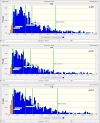Seasonal evaluation of culturable bioaerosols and airborne particulate matter in Iranian hospital wards using a Monte Carlo health risk model
- PMID: 40593985
- PMCID: PMC12216670
- DOI: 10.1038/s41598-025-04182-2
Seasonal evaluation of culturable bioaerosols and airborne particulate matter in Iranian hospital wards using a Monte Carlo health risk model
Abstract
This study aimed to measure fine particulate matter (PM) concentrations and culturable bioaerosols (bacteria and fungi) in the indoor air of operating (OR) and emergency (EM) rooms, as well as internal wards (INT) in hospitals in Bushehr city, Iran. For the first time, the Monte Carlo model was employed to assess health risks associated with PM release into hospital indoor air, focusing on healthcare workers. A four-stage impactor and a one-step Anderson contact sampler were used to determine PM and bioaerosols, respectively. To assess the non-cancer risk associated with contaminants (PM), we calculated the Hazard Quotient (HQ). This evaluation was conducted using Crystal Ball software, which performed 1000 independent iterations at a 95% confidence level. The highest PM concentration recorded was 115.6 μg/m3 in the EM. Based on the results of the Monte Carlo, most calculated hazard quotient (HQ) values exceeded acceptable levels (< 1) for staff. The maximum concentrations of bacteria and fungi were 767 and 776 cfu/m3 in the EM during summer. A positive correlation was found between fungal levels and humidity in hospital wards. Additionally, PM concentrations of larger sizes and bacteria increased during visiting hours. Most bioaerosol concentrations were above the standard values recommended by WHO. As a result of this study, continuous monitoring and control of indoor air pollutants in these environments are vital to prevent various diseases in healthcare employees and patients.
Keywords: Bacteria; Fungi; Hospital; Indoor air; PM; Risk assessment.
© 2025. The Author(s).
Conflict of interest statement
Declarations. Competing interests: The authors declare no competing interests.
Figures







Similar articles
-
Public health implications of bacterial and fungal bioaerosol concentrations in outdoor air.Sci Rep. 2025 Jul 2;15(1):22706. doi: 10.1038/s41598-025-08196-8. Sci Rep. 2025. PMID: 40593141 Free PMC article.
-
Fan Exhaust Air Sampling of Livestock Operations as a Proxy for Indoor Bioaerosol Monitoring.J Agric Saf Health. 2025 Apr 29;31(2):121-132. doi: 10.13031/jash.16127. J Agric Saf Health. 2025. PMID: 40794935
-
Microbial indoor air pollution in Delhi Metropolitan City is attributable to severe respiratory and general health effects among residents.Front Public Health. 2025 Jul 24;13:1626827. doi: 10.3389/fpubh.2025.1626827. eCollection 2025. Front Public Health. 2025. PMID: 40777639 Free PMC article.
-
Effectiveness of interventions to reduce household air pollution and/or improve health in homes using solid fuel in low-and-middle income countries: A systematic review and meta-analysis.Environ Int. 2017 Jun;103:73-90. doi: 10.1016/j.envint.2017.03.010. Epub 2017 Mar 22. Environ Int. 2017. PMID: 28341576
-
New generation sequencing: molecular approaches for the detection and monitoring of bioaerosols in an indoor environment: a systematic review.Rev Environ Health. 2024 Jan 15;40(1):47-62. doi: 10.1515/reveh-2023-0004. Print 2025 Mar 26. Rev Environ Health. 2024. PMID: 38214730
References
-
- Maji, S. et al. Short term effects of criteria air pollutants on daily mortality in Delhi, India. Atmos. Environ.150, 210–219 (2017).
-
- Klepeis, N. E. et al. The National Human Activity Pattern Survey (NHAPS): A resource for assessing exposure to environmental pollutants. J. Eposure Sci. Environ. Epidemiol.11(3), 231–252 (2001). - PubMed
-
- Mohammadyan, M. et al. Particulate air pollution at schools: Indoor–outdoor relationship and determinants of indoor concentrations. Aerosol Air Qual. Res.17(3), 857–864 (2017).
-
- Bukhari, S. S. I. & Ali, Z. Characterization of bioaerosols and particulate matter (PM) in residential settings of asthmatic patients of Lahore, Pakistan. Iran. J. Allergy Asthma Immunol.20(2), 147–159 (2021). - PubMed
MeSH terms
Substances
LinkOut - more resources
Full Text Sources
Medical
Research Materials

